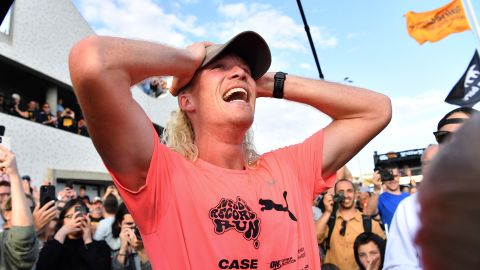[ad_1]
CNN
—
To get a sense of how vast Australia really is, just ask Nedd Brockmann. He found out the hard way.
When Brockmann arrived at Sydney’s Bondi Beach on Monday – his unmistakable, bleach-blonde mullet pinned down under a baseball cap – it signaled the end of a 2,456-mile (3,953km) running voyage that had started on the opposite side of Australia 47 days prior.
It’s difficult for the 23-year-old to know where to start when recounting the physical toll placed on his body since setting off from Cottesloe Beach in Perth last month – the countless injuries, the endlessly aching joints, the sleep deprivation, the blisters or even the maggots growing in his toes.
That all explains the joy and relief etched across Brockmann’s face when he finally arrived to hordes of people at Bondi – Australia’s iconic surfing beach – and marked the occasion by draining champagne from his sweat-soaked shoe.
“I’d been through hell and back 10 times to get there – through every injury, all the sun, the rain, the road trains, the roadkill, the weather, the headwinds,” Brockmann tells CNN Sport. “Just to get through that and then to finally see that amount of people in Bondi was out of this world. I couldn’t believe it.”
Brockmann, an electrician originally from Forbes, New South Wales, has endeared himself to the Australian public over the course of his transnational run, so much so that many are calling for him to be crowned Australian of the Year in 2023.
As of Friday, he has raised two million Australian dollars ($1.26 million) – almost double his initial target – for homeless charity We Are Mobilise through his run across Australia, covering an average of more than 50 miles a day for 47 days.

Brockmann took up running before the pandemic, primarily as a way to lose weight. His love for the sport started to grow, and so too did the length of his runs – from half marathons to marathons to ultramarathons up to 62 miles long.
In 2020, he decided to run 50 marathons in 50 days and raised close to 100,000 Australian dollars ($63,000) for the Red Cross in the process.
His appetite for a challenge only increasing, he set his sights on the run across Australia at the start of this year and eventually hit the road on September 1 – beginning a journey that would take him to the edge of his physical limits and beyond.
The first major hurdle came on day 12 when severe inflammation around a tendon in his shin prevented Brockmann from running at all. He drove 14 hours with his team for an MRI scan and, after receiving three injections to dull the pain, drove 14 hours back to his planned route to continue his run, now armed with an ankle band to help lift his foot off the floor.
And that wasn’t the only physical barrier he would confront.
“(There was) the knee pain, I had lots of foot pain, the IT [iliotibial] bands were gone, my hips were pretty busted, glutes – it was pretty all around, the injuries,” says Brockmann.
“If you’re going to get injured, you’re going to get injured with the amount of kilometers that we run. It’s in your head then – it’s got nothing to do with physicality, it’s a mind game.”

On top of his injuries were a chronic lack of sleep – Brockmann says he survived off two hours’ sleep a night for the first three weeks – and the ever-present challenge of consuming between 8,000 and 10,000 calories a day to compensate for the 10,000 to 12,000 he was burning.
“Oats in the morning with banana and coffee,” he says of his diet, “and then I was eating bacon and egg rolls – two of them – apple turnovers, pancakes, donuts, ham and cheese croissants, chicken wraps, ham and cheese toasties. You name it, I was eating it.”
Mostly running alongside traffic on the side of Australia’s long, straight roads, Brockmann also had to contend with 30-ton lorries that would rattle past him periodically.
“Every third vehicle is a big road train with four trailers on it, three trailers on it, trying to run me off the road,” he says. “So that was pretty alarming … and some of the winds when they drive past you – it just drags you into the track and pulls you away. With my little figure now, I was getting thrown around.”
Over the course of his 47-day run, Brockmann learned to endure. “Get comfortable being uncomfortable” became the mantra by which he would sign off his daily posts on Instagram, along with updates about the amount of pain pulsing through his body.
“I have never seen an athlete like this before, who can endure pain and keep pushing forward,” Brockman’s physio wrote in an Instagram post this week. “It has redefined the amount of pain and suffering someone is able to endure.”
Brockmann puts it differently. “I think 70-80% of it was like: we’re in the depths of hell,” he says, “and 20% of it was pretty okay.”

After weeks of waking up at 3:30 a.m. to avoid spending too long running in Australia’s relentless heat, Brockmann is now ready to catch up on sleep. He has no immediate plans to return to his day job as an electrician, instead devoting time to reflecting on what he’s just achieved.
He was four days short of the fastest ever crossing of Australia by foot but believes that became a blessing in disguise.
“People were just so inspired by the getting up each day, and that’s what this run became,” says Brockmann. “I think if it was all just based on the record then I wouldn’t have had this support; we wouldn’t have raised this money and we wouldn’t be where we are today.”
And for all the pain he endured and the relief he feels now that the hours spent slogging along roadsides are over, part of him will also miss the highs and the lows of the past seven weeks.
“I know I’m going to have a crash and I’m going to be quite down,” says Brockmann. “It’s a matter of talking about it, getting it out and getting excited for life now.”
[ad_2]
Source link



